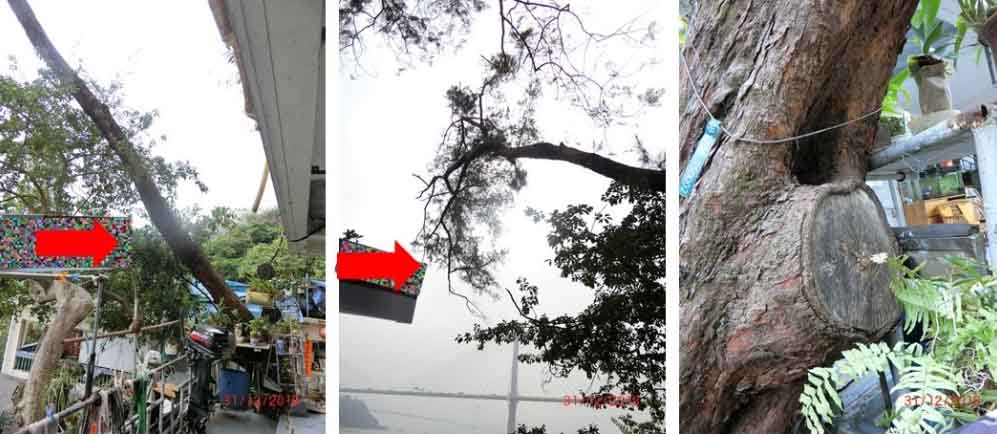1. Tree species and size
The assessed tree was a mature Casuarina equisetifolia 木麻黃 . The tree had 541mm diameter at breast height (measured 1.3m above ground), 1 no. of trunk. Height was 14m and crown spread was 6m.
2. Target and location
The site was a beach-side slope area, the tree located nearby a building in Approach Beach Hong Kong which was constantly used by people. The target rating is high, here is summarized existing target situation in below table 2.1:
Table 2.1 Existing target situation:
| Target existing (Y/N) | Target removable(Y/N) | Site use restricted(Y/N) | Frequency of use |
| Y | N | N | Constantly |
The existing Targets cannot be removed from the area or be restricted in their access. Tree Risk Assessment on an Area Basis defines a high use area as having high risk and is considered under Category 1 tree risk management zone.
3. General Condition
Sparse foliage, leaves color and size were normal. Poor tree form posed at 40-degree leaning. Average tree vigor and low live crown ratio. About 20% crown was lost.
4.Tree Defects
40-degree leaning was recorded. Moderate dead branches were observed. Codominant leaders were observed. Old wound was found on trunk. Insignificant trunk decay with a dimension 35mm length, 30mm width 20mm depth was observed with developed wound wood. Low crooked branch was observed. Root was severely restricted by a fence, flooring tiles, rocks, and concrete. The floor appeared cracks which caused by roots. Exposed root was observed.
5. Site Condition
The tree was planted in less than 1 sq. meter area with sandy soil. Tree located the edge of a group of tree and exposed to prevailing wind direction. A building was nearby the tree, constantly use with people. Target rating was high. If the tree failure might cause a severe hazard.
6. Conclusion and Mitigation Measure
This tree was getting serious situation after typhoon Mangkhut’s attack. New 40-degree leaning was recorded, the last inspection was 30-degree record in Jun 2018. With reference to Dr. Kim D. (Sept 2000), the tree >25-degree should be removed immediately. The larger the lean the more difficult it is to project dynamic loading and the greater the complexity in
defending leaving the tree standing.
Leaning was getting that serious because the tree could not withstand the strong wind from the typhoon. Obvious cracks on the floor might be caused by root plate uplift movement. The tree takes time to self-correct for the lean with response growth. As the leaning tree was structurally unstable and weight was unbalanced, the root system was burdened. Additionally, the root system was 50% restricted by fencing, concrete, tiles. The root is hard to rebuild a structurally sound root in this condition. The soil was sandy, compacted and unstable, the chance of tree falling is high. Dead branches observed in crown indicated that the root system was damaged and the tree under stress. Furthermore, the location was rated as high because the occupancy rate was constantly and frequent people walk around here. The risk rating is high. The removal of the tree is proposed for the sake of public safety.
7. Tree photos




1. codominant leaders, 2 decays on the branch in which wound wood were observed
2. minor crooked branch
3. mechanical injury on root collar
4.exposed root.
8. Tree Plan
Citation
Estimating leaning tree failures
Dr. Kim D. Coder, Professor, University of Georgia. (2000). Estimating leaning tree failures.